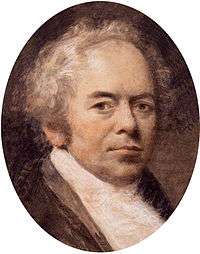William Artaud

William Artaud (1763–1823), was an English painter of portraits and biblical subjects.
Life
Artaud was the son of a London jeweller. He was awarded a premium at the Society of Arts in 1776, and first exhibited at the Royal Academy in 1780. He was a student at the Royal Academy Schools, winning a silver medal in 1783, the gold medal, (for a subject from Paradise Lost) in 1786, and the travelling studentship nine years later.[1]
He painted both portraits and biblical subjects. His sitters included Francesco Bartolozzi, Samuel Parr (now in the collection of the Warwickshire Museum Service)[2] Joseph Priestley, William Herschel and other leading figures of the day. Some of his biblical subjects were engraved for Macklin's Bible. The art historian Georg Kasper Nagler (1801–1866) gives a list of engravings after Artaud's paintings in his New General Dictionary of Artists'.[3]
He last exhibited at the Royal Academy in 1822.[3] The date of his death is not known.
Samuel Redgrave said of him "his portraits were cleverly drawn, and painted with great power. They have individuality of character, but want expression."[1]
References
- 1 2 Redgrave, Samuel (1878). A Dictionary of Artists of the English School:. London: George Bell and Sons.
- ↑ "Dr Samuel Parr (1747–1825), DD". BBC Your Paintings. Retrieved 15 October 2012.
- 1 2
 "Artaud, William". Dictionary of National Biography. London: Smith, Elder & Co. 1885–1900.
"Artaud, William". Dictionary of National Biography. London: Smith, Elder & Co. 1885–1900.
Sources
- This article incorporates text from the article "ARTAUD, William" in Bryan's Dictionary of Painters and Engravers by Michael Bryan, edited by Robert Edmund Graves and Sir Walter Armstrong, an 1886–1889 publication now in the public domain.
 This article incorporates text from a publication now in the public domain: "Artaud, William". Dictionary of National Biography. London: Smith, Elder & Co. 1885–1900.
This article incorporates text from a publication now in the public domain: "Artaud, William". Dictionary of National Biography. London: Smith, Elder & Co. 1885–1900.
Further reading
- Albert Charles Sewter. The life, work and letters of William Artaud 1763–1823 (University of Manchester, 1951)
External links
| Wikimedia Commons has media related to William Artaud. |
- William Artaud online (Artcyclopedia)